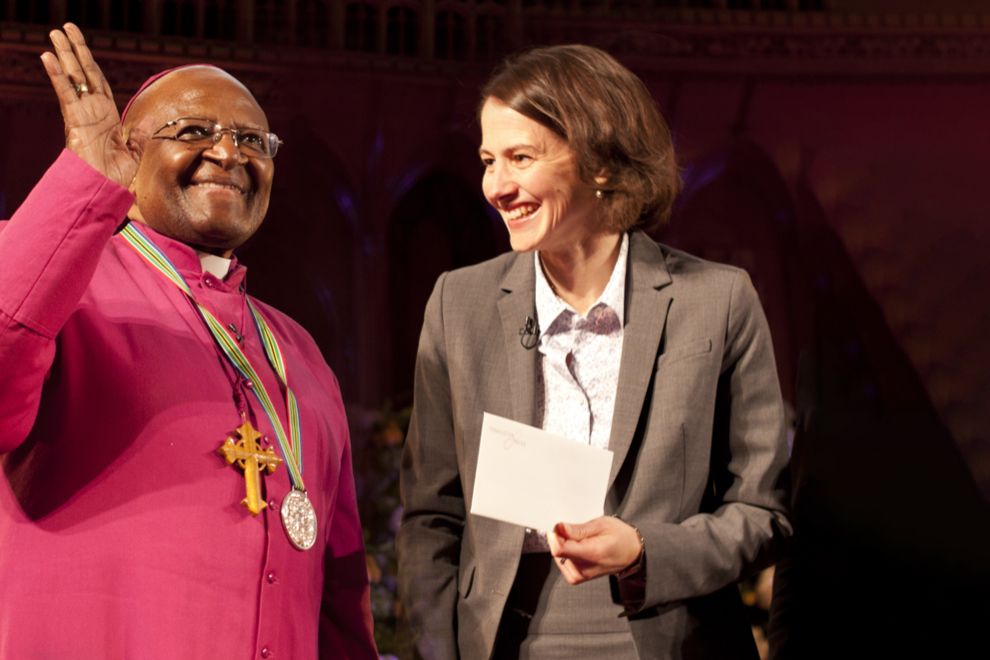Established in 1972, the Templeton Prize was celebrated investor Sir John Templeton’s first major philanthropic venture.
He created the Templeton Prize because he wanted to recognize discoveries that yielded new insights about religion and he set the award amount above that of the Nobel Prizes in order to recognize the importance of what he called “progress in religion.” His understanding of progress in religion evolved during his lifetime and is shown in the variety among the 53 Laureates who have received the Prize. Winners have come from all major faiths and dozens of countries and have included Nobel Prize winners, philosophers, theoretical physicists, and one canonized saint.
Throughout the decades, the Prize always reflected Sir John’s core conviction that there is a deeper level of reality that can be accessed through rigorous research, especially in the sciences. For the first few decades of the Prize, HRH Prince Philip presented the award, and distinguished leaders such as His Holiness the Dalai Lama, Dame Margaret Thatcher, and Presidents George H.W. Bush and Gerald Ford served as judges.
In 2020, the Templeton philanthropies updated the description of the Templeton Prize, focusing it on research, discovery, public engagement, and religious leadership that advance our understanding of, and appreciation for, the insights that science brings to the deepest questions of the universe and humankind’s purpose and place within it.
Read on to explore the history of the Templeton Prize.

1972 - 1973
Sir John Templeton establishes the Templeton Prize.
He makes the monetary value of the Prize more than the amount of the Nobel Prize to reflect his belief that progress in religion is no less important than progress in any other area.
In 1973, HRH Prince Philip, husband of Queen Elizabeth II, presides at the first public ceremony honoring Mother Teresa in London’s historic Guildhall. Subsequently, most recipients also attend a private ceremony at Buckingham Palace.
PHOTOGRAPH: HRH Prince Philip, Duke of Edinburgh, and Mother Teresa of Calcutta. Guildhall, London, April 24, 1973. (Credit: Templeton Prize)

The 1970s
Celebrating the first 10 years of Templeton Prize Laureates.
During its first decade, Templeton Prize Laureates include religious leaders such as Chiara Lubich, founder of the grassroots religious movement known as Focolare that is committed to social justice, peace, and ecumenism; Dame Cicely Saunders, originator of the modern hospice movement; the philosopher and Indian statesman Sir Sarvepalli Radhakrishnan, who contributed to the cross-fertilization of eastern and western thought; and Rev. Nikkyo Niwano, founder of Rissho Kosei-kai and the World Conference on Religion and Peace.
PHOTOGRAPH: Dame Cicely Saunders and HRH Prince Philip, Duke of Edinburgh at Buckingham Palace, May 12, 1981. (Credit: Templeton Prize-Clifford Shirley)

The 1980s
Sir Alister Hardy, a marine biologist, becomes the first scientist to win the Templeton Prize.
He begins a line of scientists and science scholars including Stanley Jaki (1987), Carl Friedrich von Weizsäcker (1989) (photo left), L. Charles Birch (1990), Paul Davies (1995), Ian Barbour (1999), Freeman Dyson (2000), Arthur Peacocke (2001), John Polkinghorne (2002), George Ellis (2004), Nobel laureate Charles Townes (2005), John D. Barrow (2006), Michael Heller (2008), Martin Rees (2011), and Marcelo Gleiser (2019).
In 1989, the public ceremony moves from London to Tokyo, beginning a period in which it takes place in cities around the world, including Moscow, Rome, Toronto, Berlin, Vancouver, Washington DC, and the United Nations in New York.
PHOTOGRAPH: (Credit: Templeton Prize-Clifford Shirley)

The 1990s
The Templeton Prize ceremony is held for the first time in the United States at the Rockefeller Memorial Chapel at the University of Chicago (Charles W. Colson, 1993).
The ceremony returns to the U.S. in later years, with events at The Field Museum in Chicago (Alvin Plantinga, 2017), Washington National Cathedral (Freeman Dyson, 2000 and King Abdullah II of Jordan, 2018) and in New York at the United Nations (Sir Sigmund Sternberg, 1998) and The Metropolitan Museum of Art (Marcelo Gleiser, 2019).
PHOTOGRAPH: HRH Prince Philip, Duke of Edinburgh, and Rev. Kyung-Chik Han at the Templeton Prize presentation in Buckingham Palace, April 1992. (Credit: Templeton Prize-Clifford Shirley)

The 2000s to Present
Renowned religious figures and leading scientists carry home the Templeton Prize as it looks ahead to a new era.
A series of scientists win the Templeton Prize beginning with Freeman Dyson in 2000. In 2011, following the presentation of the Prize to Sir Martin Rees, Prince Philip retires as presenter of the Templeton Prize at age 90.
In later years, acclaimed religious leaders are recognized with the award. In 2012, the Dalai Lama receives the Prize at St. Paul’s Cathedral before an audience of over 2,000. His award appears on the front page of the Times (London). The following year, Archbishop Desmond Tutu becomes the second South African to win the award, with a celebration at St. George’s Cathedral in Cape Town and a ceremony at Guildhall.
PHOTOGRAPH: Archbishop Emeritus Desmond Tutu and Heather Templeton Dill. Guildhall, London, May 21, 2013. (Credit: Templeton Prize-Clifford Shirley)
